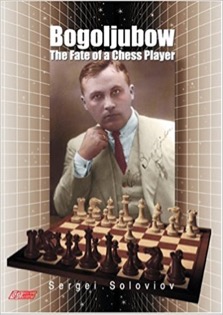Bogoljubow the Fate of a Chess Player
Sergei Soloviov

Though I usually post reviews of new books, sometimes an old, forgotten book is well worth discussing. All true chess fans have heard of Efim Dmitrievich Bogoljubow (born April 14, 1889, died June 18, 1952), but most dont know much about him. Yes, this legendary player lost two hard fought World Championship matches against Alekhine, but what else did he achieve?
Looking for material on Bogoljubow, serious literature on this man is extremely hard to find. Fortunately, Sergei Soloviov gave us the ultimate book on Bogo. He tells you about his youth, gives details of all his tournaments (with clear, extremely useful tournament cross tables), discusses his move to grandmaster strength and challenger to the World Championship, and his continued tournament battles right up to his death.
Heres what Soloviov wrote about Bogoljubows final days:
Finally, it was May of the year 1952. A big international tournament was organised in Belgrade with 20 participants. This was where grandmaster Bogoljubow played the last tournament games in his life. Of course, it was very difficult for him to withstand such tiring competition and his heart was evidently creating more and more problems for him. He managed to play well in some of the games though, and he scored 9 out of 19. The Argentinian player Pilnik won the tournament and until 1930 he had been living in Stuttgart, only 100 kilometres away from Bogoljubow!
Bogoljubow was still full of energy. Immediately after the end of the tournament, Efim Dmitrievich went back to Triberg for a training camp with the German junior team. One of his students, the future grandmaster Darga, shared first place in the World Junior Championship the next year. After the training camp, he went for a ten-day exhibition tour with simultaneous displays along the route Pfortzheim Hallbronne (close to Stuttgart). The next day, after he had returned home from the tour, he died in his sleep. It was June 18, 1952.
Here are the chapters:
Chapter 1: The road to mastership (Games 1909-1914)
Chapter 2: Master. War, Chess, Love (Games 1914-1915)
Chapter 3: The Road to the Top 1. Grandmaster Games 1919-1924
Chapter 4: The Road to the Top 2.Coming Back. Idol of the Country (Games 1924)
Chapter 5: At the Top (Games 1925)
Chapter 6: Non-Soviet Person, or Va – Banque (Games 1926-1927)
Chapter 7: New Successes. World FIDE Champion. Challenging Alekhine to a Match (Games 1928-1929)
Chapter 8: The Year 1929. The First Attempt (Games 1929)
Chapter 9: The Years 1930 to 1934 (Games 1930-1933)
Chapter 10: The Year 1934. The Last Attempt (Games 1934)
Chapter 11: Politics, Politics (Games 1935-1938)
Chapter 12: The War (Games 1939-1943)
Chapter 13: The End (Games 1947-1952)
Each chapter shares incredible information about his life (chess and personal), and each chapter gives many games (all annotated).
Bogoljubow started to play serious chess around 1909, at the age of 20, and he quickly became a force to be reckoned with. He was grandmaster strength by 1920, and by 1925 he was one of the best five players in the world. He tied for first in a strong tournament in January at Leningrad (1925) to start off, then he came in 4th below Alekhine, Rubinstein, Saemisch, but ahead of Tartakower, Marshall, Rabinovich, Greenfield, Nimzowitsch, Torre, Reti, Treybal, Spielmann, and many more. He followed this by winning clear first in the USSR Championship, and he won another strong event two points ahead of his competitors (Nimzowitsch, Rubinstein, Greenfield, Reti, Saemisch, Tarrasch, etc). One would think that this would be more than enough to show he was one of the very best. However, the next event blew everyones mind: Clear first in Moscow a point and a half ahead of Emanuel Lasker (who came in second), Casablanca (who came in third), Marshall, Torre, Tartakower, Reti, Rubinstein, Spielmann, etc. Clearly, Bogoljubows results in 1925 (one of the best years any player has ever had) made it clear that he was a true World Championship contender, perhaps only behind Capablanca, Alekhine, and Lasker.
Tartakower wrote: Capablanca forges, Alekhine struggles, Lasker thinks, and Bogoljubow lets his imagination run away with him. But he sometimes achieves the highest results too.
Clearly, anyone that is placed in the same company as Capablanca, Alekhine, and Lasker should be studied in depth. If you have interest in chess history, or if you like to go over the games of the worlds best players, Bogoljubow The Fate of a Chess Player is a no-brainer. It is, without doubt, the best book on this legendary super-player thats ever been written.
